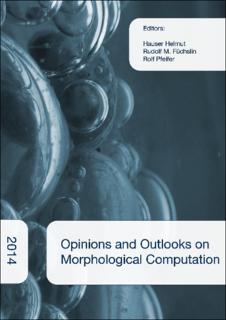Please use this identifier to cite or link to this item:
https://doi.org/10.21256/zhaw-3157| Publication type: | Book |
| Type of review: | Peer review (publication) |
| Title: | Opinions and outlooks on morphological computation |
| et. al: | No |
| Editors: | Hauser, Helmut Füchslin, Rudolf Marcel Pfeifer, Rolf |
| DOI: | 10.21256/zhaw-3157 |
| Extent: | 244 |
| Issue Date: | 2014 |
| Publisher / Ed. Institution: | Universität Zürich |
| Publisher / Ed. Institution: | Zürich |
| ISBN: | 978-3-033-04515-6 |
| Language: | English |
| Subjects: | Morphoological Computation; Robotics; Simulation; Bio - inspired engineering |
| Subject (DDC): | 620: Engineering |
| Abstract: | Morphological Computation is based on the observation that biological systems seem to carry out relevant computations with their morphology (physical body) in order to successfully interact with their environments. This can be observed in a whole range of systems and at many different scales. It has been studied in animals – e.g., while running, the functionality of coping with impact and slight unevenness in the ground is "delivered" by the shape of the legs and the damped elasticity of the muscle-tendon system – and plants, but it has also been observed at the cellular and even at the molecular level – as seen, for example, in spontaneous self-assembly. The concept of morphological computation has served as an inspirational resource to build bio-inspired robots, design novel approaches for support systems in health care, implement computation with natural systems, but also in art and architecture. As a consequence, the field is highly interdisciplinary, which is also nicely reflected in the wide range of authors that are featured in this e-book. We have contributions from robotics, mechanical engineering, health, architecture, biology, philosophy, and others. On one hand, the beautiful richness of this interdisciplinarity has a lot of potential, but on the other, it poses a number of serious challenges. For example, people with different backgrounds have a different understanding of the concepts involved. They use different terms for the same ideas or, even more problematic, they use the same terms to mean something often substantially different. Also, the tools and methods are frequently quite apart, as illustrated, e.g., by engineering and neuroscience. Nevertheless, we strongly believe that this interdisciplinarity is a big opportunity, which enables the field to grow and to cross-fertilize. Scientists from other areas can provide novel points of view, they can challenge long standing, many times implicit and unquestioned assumptions inherent to a field, and they can help to find disruptive approaches to solve notorious problems. We would even argue that a lot of times truly novel and seminal work happens exactly at the intersection of different fields. Based on the strong belief that – if done right – interdisciplinary research can be enormously productive we had initiated this e-book. The intention was to collect opinions on morphological computation from researchers from a broad range of research as well cultural backgrounds. Instead of the formal style of publications of scientific results, we wanted to provide a rather informal environment where people can present their point of view on morphological computation, its future trajectory and its possibly far-reaching implications. The book should be an inspirational resource and it should allow for cross-fertilization between different disciplines. One of our goals was to make sure that the contributions are written in a style accessible for a broad audience. Moreover, it was clear from the very beginning that this e-book should be available for free to lower the threshold to read it. In our opinion we have been able to meet the objectives of the e-book, especially, because of the help of all authors who took the effort to write excellent contributions. We are truly grateful for all their work and we also appreciate their patience to "hang in there" with us so long. Finally, we hope that this colorful collection of thoughts will inspire researchers, engineers, students, teachers, and anyone with an interest in scientific debate, alike and will generate a lot of discussion and ultimately novel scientific topics. |
| Further description: | This book is published jointly by the editors Helmut Hauser, Rudolf M. Füchslin and Rolf Pfeifer. It is a free ebook and distribution is encouraged. |
| URI: | https://digitalcollection.zhaw.ch/handle/11475/17668 |
| Fulltext version: | Published version |
| License (according to publishing contract): | CC BY-SA 4.0: Attribution - Share alike 4.0 International |
| Departement: | School of Engineering |
| Organisational Unit: | Institute of Applied Mathematics and Physics (IAMP) |
| Appears in collections: | Publikationen School of Engineering |
Files in This Item:
| File | Description | Size | Format | |
|---|---|---|---|---|
| full_ebook_Opinions_and_Outlooks_on_Morphological_Computation.pdf | 134.09 MB | Adobe PDF |  View/Open |
Show full item record
Hauser, H., Füchslin, R. M., & Pfeifer, R. (2014). Opinions and outlooks on morphological computation. Universität Zürich. https://doi.org/10.21256/zhaw-3157
Hauser, H., Füchslin, R.M. and Pfeifer, R. (eds) (2014) Opinions and outlooks on morphological computation. Zürich: Universität Zürich. Available at: https://doi.org/10.21256/zhaw-3157.
H. Hauser, R. M. Füchslin, and R. Pfeifer, Eds., Opinions and outlooks on morphological computation. Zürich: Universität Zürich, 2014. doi: 10.21256/zhaw-3157.
HAUSER, Helmut, Rudolf Marcel FÜCHSLIN und Rolf PFEIFER (Hrsg.), 2014. Opinions and outlooks on morphological computation, 2014. Zürich: Universität Zürich. ISBN 978-3-033-04515-6
Hauser, Helmut, Rudolf Marcel Füchslin, and Rolf Pfeifer, eds. 2014. Opinions and Outlooks on Morphological Computation. Zürich: Universität Zürich. https://doi.org/10.21256/zhaw-3157.
Hauser, Helmut, et al., editors. Opinions and Outlooks on Morphological Computation. Universität Zürich, 2014, https://doi.org/10.21256/zhaw-3157.
Items in DSpace are protected by copyright, with all rights reserved, unless otherwise indicated.